#Maotianshan Shales
Explore tagged Tumblr posts
Text
despite heated arguments, we steer the submarine/time machine towards The Gaping Maw.

This is a continuation of these posts and is an ongoing choose your own adventure story! (1) (2)
#Cambrian#Paleontology#Palaeoblr#Prehistoric Life#Maotianshan Shales#Palaeoblr Choose Your Own Adventure#polls
574 notes
·
View notes
Text
Fossil Friday: Hallucigenia

Believe it or not, this walking caltrop is actually an animal called Hallucigenia sparsa. It is a genus of lobopodian, basically a stubby-legged worm. Kind of like this modern day velvet worm:

Hallucigenia was a tiny animal no bigger than 5.5. cm long, as shown in the photo below where the blue line represents 3mm.

It had up to 10 legs, the first 2 or three pairs were slender and featureless but the rest ended in paired claws.

Above the trunk, or main part of the body, are seven pairs of spines or sclerites. The longer end is the head which has an anteroventral (front/bottom) mouth and two simple eyes. The "tail" droops down on the other end.

It was first found in the Burgess Shale in Canada along with all the other crazy soft-bodied Cambrian fauna found there. A second species, H. fortis, was found in the Chengjiang Biota of China (Maotianshan Shale.)

It lived on the sea floor and it is often found in association with the sponge Vauxia, which it may have eaten.

#paleontology#fossils#geology#fossilfriday#hallucigenia#velvet worm#lobopod#burgess shale#Maotianshan Shale#canada#china#paleontologist#weird animals
56 notes
·
View notes
Text

The Paleo Party Guest of the day is Hallucigenia!
This lobopodian worm was upside down for a good time, we thought the spines were their legs, and their butt was their face. Lovely :)
Age: ~520-510 Million years ago
Location: Burgess Shale, British Colombia, Canada and Maotianshan Shale, China
Stickers || Phone Wallpapers Masterlist
57 notes
·
View notes
Text
Perspectives #7

"Garden of Cambrian Sights”
Innovatiocaris/Microdictyion/Haikouichthys/Eldonia/Fortiforceps
Cambrian, 518 million years ago, Maotianshan Shales (China) The Chengjiang Biota was composed of a hugely diverse array of invertebrates. Just in this picture alone, you have Innovatiocaris, Microdictyon, Fortiforceps, Eldonia, Haikouichthys, primitive annellids, priapulida, sponges, and echinoderms. It might not have always looked as helish as this, though... Based on the third panel of "The Garden of Earthly Delights" by Hieronymous Bosch.
This is a part of my Perspectives series! You can find previous entries in #perspectives on my blog.
#yee art#paleoart#paleoblr#palaeoblr#cambrian#fossil#nature art#ocean#innovatiocaris#lobopod#anomalocaris#cambrian explosion#worms#eldonia#haikouichthys#fortiforceps#sponge#shrimp#perspectives
82 notes
·
View notes
Photo

Omnidens amplus
Omnidens amplus is an extinct panarthropod from the Cambrian Maotianshan Shales of China. It could grow up to 1.5 metres (4.9 ft) in body length.
License this stock resource at: https://paleostock.com/resource/omnidens-amplus-stock-photo
Illustration by Prehistorica
#paleoart#sciart#science#nature#paleontology#geology#fossil#fossils#evolution#art#illustration#paleostock
112 notes
·
View notes
Text
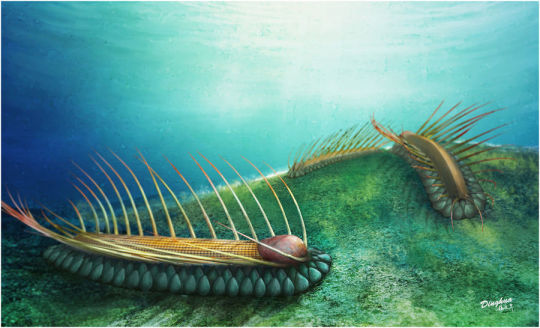
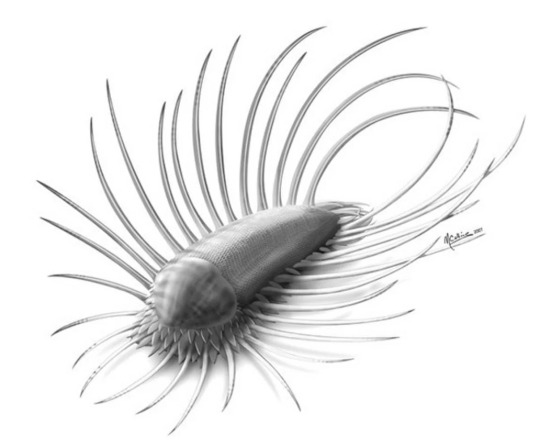
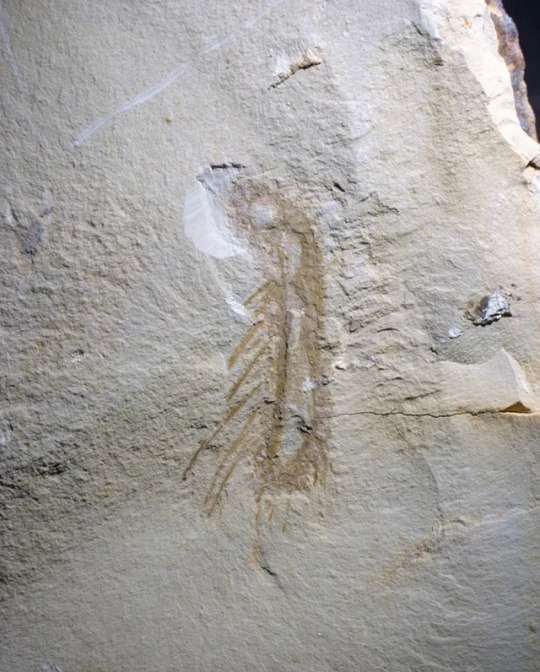
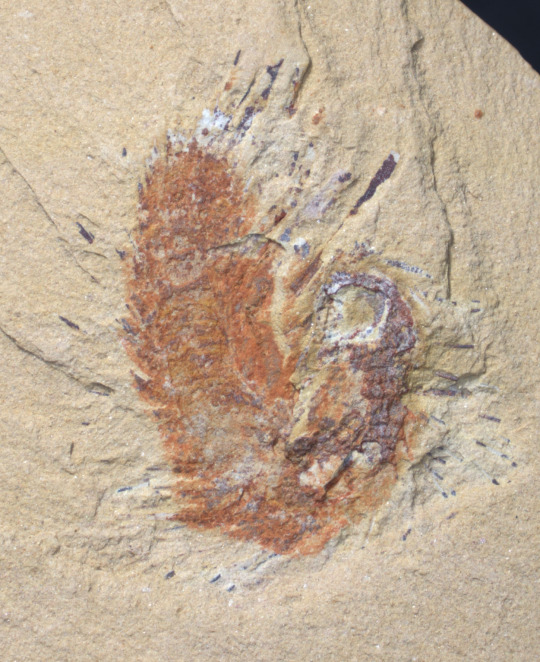
Orthozanclus
(size: 6 to 11 mm / 0.24 to 0.43 "; temporal range: 505 mio. years ago)
[text from the Wikipedia article, see also link above]
Orthrozanclus (from Greek ὄρθρος + ζᾰ́γκλος (órthros + zánklos), "dawn scythe") is a genus of sea creatures known from two species, O. reburrus from the Middle Cambrian (~505 million years ago) Burgess shale and O. elongata from Early Cambrian (~518 million years ago) Maotianshan Shales. Animals in this genus were one to two centimeters long, with spikes protruding from their armored bodies. The placement of this genus into a specific family is not universally accepted.
3 notes
·
View notes
Text
Fun Cambrian fact #27:
Ascidians are soft bodied animals, and for this reason, their fossil record is almost entirely lacking. The earliest reliable ascidians is Shankouclava shankouense from the Lower Cambrian Maotianshan Shale (Yunnan, South China).

sea squirts she squirts by the sea shore
6 notes
·
View notes
Text
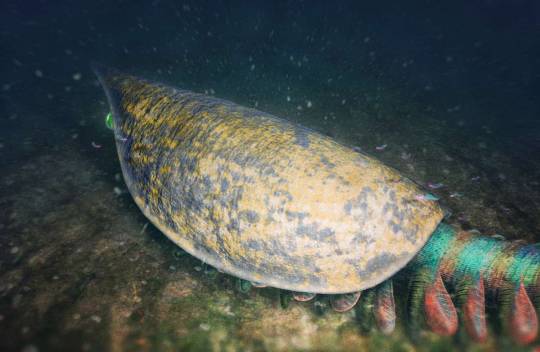
Cucumericrus
Cucumericrus — це рід ймовірних радіодонтів, відомий за кількома погано збереженими зразками знайденими в китайській провінції Юньнань у Сланцях Маотяньшань (Maotianshan Shales), що датуються середнім кембрієм. Були виявлені лише фрагменти кутикули тулуба та відповідних придатків, тоді як важливі ознаки радіодонтів, такі як передні придатки, у цього роду невідомі. Типовий вид – Cucumericrus decoratus.
Повний текст на сайті "Вимерлий світ":
https://extinctworld.in.ua/cucumericrus/
#cucumericrus#cucumericrus decoratus#yunnan#china#cambrian#cambrian period#maotianshan shales#paleoart#prehistoric#paleontology#палеоарт#палеонтологія#вимерлі тварини#extinct animals#ukraine#доісторичні тварини#made in ukraine#ukrainian#scientific illustration#science#history#nature#animals#prehistory#україна#український tumblr#український блог#українською#український пост#art
5 notes
·
View notes
Text

a fossil a day keeps the sad vibes away
jawless fish friday?? can i get a shoutout to all the jawless fish? this guy is from the maotianshan shale beds and might be one of the first chordates, making them an ancestor to all vertebrates including you and me!
#fish#ichthyology#chordate#paleoart#paleontology#dinovember#dinovember2022#art#artists on tumblr#illustration#illustrators on tumblr#gif#procreate#mine#paleozoic pals#fossil art#digital art#palaeoblr
132 notes
·
View notes
Note
To step back millions of years ago: are there any difference in fossil Pokemon who originate from different geologic formations? Such as Kabuto from the Burgess Shale VS the Maotianshan Shales?
The fossil Pokemon present mostly depend on when the fossils were deposited and at what point in time - Omanyte fossils are typically older than Tyrunt or Amaura. The two deposits you mentioned mostly contain aquatic fossil Pokemon, so you can expect to find Kabuto, Omanyte, or Lileep in both.
14 notes
·
View notes
Text
'Strange beyond measure' sea creature unearthed in China
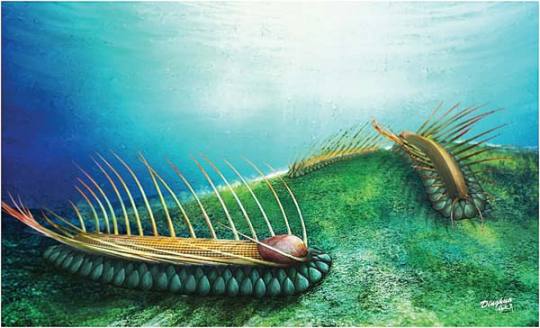
Archaeologists in China have discovered a fossilized sea creature that they describe as "strange beyond measure", with long spines along its worm-like body and a shell that covers its head, like a helmet.
The 515-million-year-old specimen was unearthed last year by a fossil collector in the hills of the Maotianshan Shales, an archaeological hotspot in Southwest China's Yunnan province.
The collector gave the fossil to Zhao Fangchen, a paleobiologist at the Chinese Academy of Sciences, who studied it, along with researchers from Durham University in the United Kingdom.
"The creature is like a mythical beast," Martin Smith, an assistant professor at Durham, told science news website Live Science. Read more.
220 notes
·
View notes
Text
this is a continuation of this and is an ongoing choose your own adventure story. If it goes well, I'll do it again!
#Cambrian#Paleontology#Palaeoblr#Prehistoric Life#Maotianshan Shales#Palaeoblr Choose Your Own Adventure#polls
528 notes
·
View notes
Text
Monday Musings: In Conclusion
This month has been dedicated to the Cambrian Period. Something most people are not aware of is that Paleozoic and Mesozoic periods are broken down into epochs and stages...just like the Cenozoic.

Just for fun I wanted to use this column of the Cambrian Period to show where all the major deposits and animals we've talked about (and a few we haven't) occurred.
Like our favorite trilobites!


Trilobites appeared in the fossil record at about 521 Ma, right at the end of Stage 2 of the Terreneuvian Epoch. Not long after that, the Chengjiang and Sirius Passet lagerstatten were deposited. This was towards the end of Stage 3 of Series 2. This is when the animal Haikouella lived.

Next is Emu Bay Shale. We haven't talked about that one yet. As you can imagine, Emu Bay is in Australia on Kangaroo Island.


It is one of two sites containing Redlichiidan trilobites.
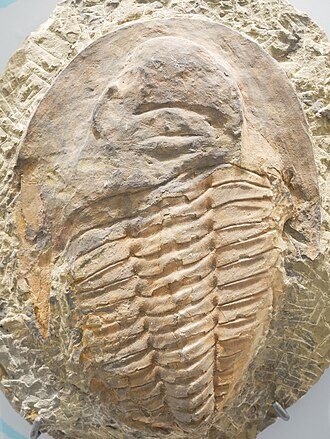
The Burgess Shale was deposited at the beginning of the Drumian Age during the Mialingian Epoch. This is when Hallucigenia and Marella lived.
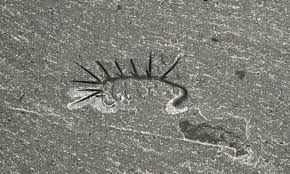

This is followed by the Wheeler Shale, Marjum and Weeks Formation sequence in the Guzhangian Age.
The final lagerstatten is the Orsten Fauna of Sweden. The fossils are just a little bit younger than the Utah ones and much smaller. This site preserved larval stages and the first fossil tardigrades.

By the end of the Cambrian there was a major faunal turnover into the Ordovician Period. Many brachiopods and conodonts died but the group that was hit the hardest was the trilobites. Those that lived on the outer edges of the shelfs and slope environments were hardly affected but those that lived in the shallow seas on the shelf were wiped out.
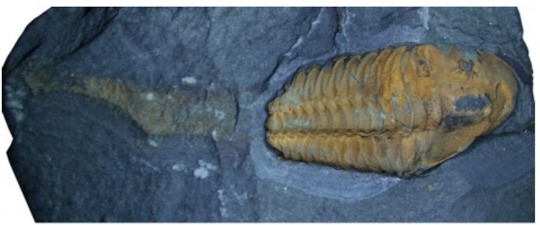
The Cambrian Period was important and I hope you enjoyed learning about it this month. Next month we will switch from geochronology to paleontology with comparative anatomy! There will be a video on the basics posted to youtube on October 19th but if you want to see it sooner then join my new Patreon! The video will be posted two weeks earlier.
There will also be interviews with my fellow paleontologists as well as lesson videos and access to the Minerals Rocks and Fossil Talks discord server. Thanks for all the support and fossilize you later!

#paleontology#fossils#fun facts#geology#cambrian period#lagerstatten#burgess shale#maotianshan shale#emu bay shale#sirius passet#wheeler shale#marjum formation#weeks formation#orsen fauna#trilobite#trilobite exticntion#marella#haikouella#hallucigenia
22 notes
·
View notes
Text
Perspectives #6

"Enter the Omnidens" Nectocaris/Vetulicola/Omnidens Cambrian, 519 million years ago, Maotianshan Shales (China) In Cambrian China, there existed the biggest beast of the Cambrian period, at a whopping *five feet long!* It was Omnidens: A giant lobopod that undoubtedly terrorized the seafloor, dwarfing practically every other organism it came across. During the Cambrian, eyes became commonplace. As such, I've decided to show bioluminescent bacteria, who now have an audience to witness their glow - which is what is attracting Omnidens to its prey; Vetulicola. We have no fucking idea what Vetulicola was, but seemingly eyeless, these individuals might not be aware that they're currently serving as a beacon for all to see. Omnidens isn't particularly agile, but nights like these when many Vetulicola gather are a bounty for it nonetheless. Trailing the Omnidens for scraps are two Nectocaris, strange mollusks that, oddly enough, were shell-less, converging on a bodyplan similar to cephalopods.
This is a part of my Perspectives series! You can find previous entries in #perspectives on my blog.
#paleoblr#palaeoblr#yee art#perspectives#cambrian#omnidens#nectocaris#vetulicola#paleoart#palaeoart#ocean#nature art#nature#paleobiology#paleontology#horror
68 notes
·
View notes
Link
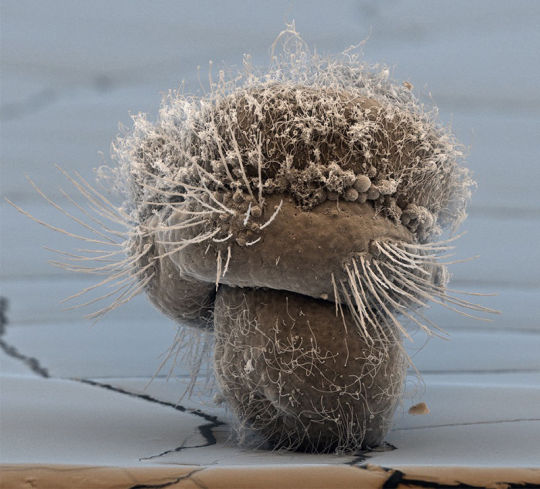
Above: Brachiopod Larvae
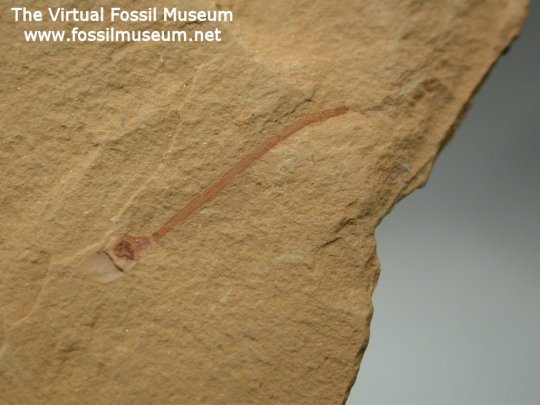
Above: 525 million year old Lingulella Brachiopod fossil from Maotianshan Shales of China, a member of the Cambrian Explosion fauna.
#science#evolution#teaching evolution#evolutionary biology#immune system#natural selection#cambrian explosion#fossil record#fossils
14 notes
·
View notes
Photo
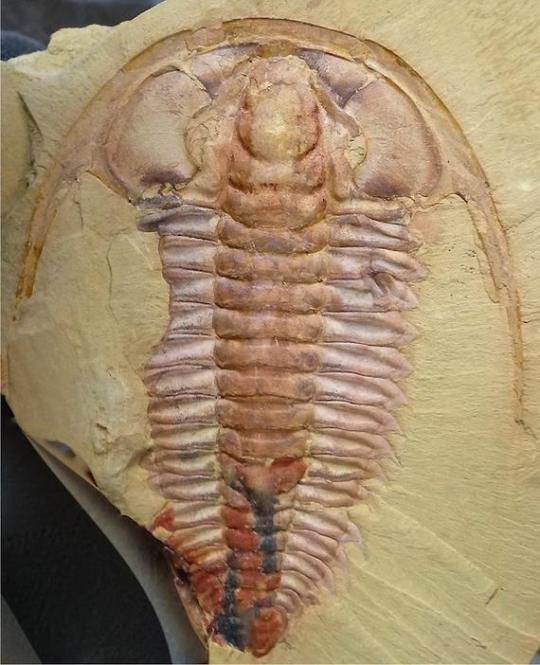
It's time for Trilobite Tuesday! In 1984, a thousand years after these layers were first noted by local residents, Chinese scientists formally described an amazing 515 million year old Lower Cambrian fauna located within the Maotianshan Shales of Chengjiang County in China's southern province of Yunnan. There, mixed amid a variety of primitive trilobite species including Eoredlichia intermedia (photo), Yunnanocephalus yunnanensis, Wutingaspis tingi and Kauyangi pustulosa, were an astounding assortment of soft-bodied creatures, many of which resembled those found in the legendary-- though 5 million years more recent-- Burgess Shale of British Columbia. Material from the Chinese site (which along with a number of other similarly-aged local layers, including the Chiungchussu and Qionzhusi formations, have become collectively recognized as the Chengjiang Biota) had been known as early as the 10th Century.
It wasn't until scientific expeditions began exploring the area in late 1970s, however, that research began to unravel the myriad scientific mysteries that lay within these 50-meter thick, hard mudstone layers. So far, 185 different species (with over half being arthropods… four being the aforementioned trilobites) have revealed themselves in the Chengjiang Biota, with the possibility that even more are still hidden within these ancient rocks, waiting to be discovered.
192 notes
·
View notes